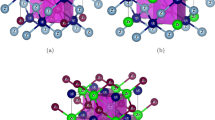Abstract.
Magnetic and electric properties of the Hubbard model with binary alloy disorder are studied within the dynamical mean-field theory. A paramagnet-ferromagnet phase transition and a Mott-Hubbard metal-insulator transition are observed upon varying the alloy concentration. A disorder induced enhancement of the Curie temperature is demonstrated and explained by the effects of band splitting and subband filling.
Similar content being viewed by others
References
M. Imada, A. Fujimori, Y. Tokura, Rev. Mod. Phys. 70, 1039 (1998)
E. Dagotto, T. Hotta, A. Moreo, Phys. Rep. 344, 1 (2001)
G. Cao et al., cond-mat/0409157
S. Yeo et al., Phys. Rev. Lett. 91, 046401 (2003)
V.I. Anisimov et al., Phys. Rev. Lett. 89, 257203 (2002)
I. Zutic, J. Fabian, S. Das Sarma, Rev. Mod. Phys. 76, 323 (2004)
T. Dietl, Semicond. Sci. Technol. 17, 377 (2002)
D. Vollhardt, N. Blümer, K. Held, M. Kollar, in Band-Ferromagnetism, edited by K. Baberschke, M. Donath, W. Nolting, Lecture Notes in Physics, Vol. 580 (Springer, Berlin, 2001), p. 191
A. Georges, G. Kotliar, W. Krauth, M.J. Rozenberg, Rev. Mod. Phys. 68, 13 (1996)
Th. Pruschke, M. Jarrell, J.K. Freericks, Adv. Phys. 44, 187 (1995)
D. Vollhardt, Correlated Electron Systems, Vol. 9, edited by V.J. Emery (World-Scientific, Singapore, 1993), p. 57
M. Ulmke, Eur. Phys. J. B 1, 301 (1998)
J. Wahle, N. Blumer, J. Schlipf, K. Held, D. Vollhardt, Phys. Rev. B 58, 12749 (1998)
A.I. Lichtenstein, M.I. Katsnelson, G. Kotliar, Phys. Rev. Lett. 87, 067205 (2001)
B. Velicky, S. Kirkpatrick, H. Ehrenreich, Phys. Rev. 175, 747 (1968)
K. Byczuk, M. Ulmke, D. Vollhardt, Phys. Rev. Lett. 90, 196403 (2003)
K. Byczuk, W. Hofstetter, D. Vollhardt, Phys. Rev. B 69, 045112 (2004)
D.I. Bardos, J. App. Phys. 40, 1371 (1969); M. Pratzer, H.J. Elmers, Phys. Rev. Lett. 90, 077201 (2003)
I. Turek, J. Kudrnovsky, V. Drchal, P. Weinberger, Phys. Rev. B 49, 3352 (1994)
H.S. Jarrett et al., Phys. Rev. Lett. 21, 617 (1968); G.L. Zhao, J. Callaway, M. Hayashibara, Phys. Rev. B 48, 15781 (1993); S.K. Kwon, S.J. Youn, B.I. Min, Phys. Rev. B 62, 357 (2000); T. Shishidou, A.J. Freeman, R. Asahi, Phys. Rev. B 64, 180401(R) (2001); J.F. DiTsua et al., cond-mat/0306541
M.B. SilvaNeto, A.H. CastroNeto, D.J. Mixson, J.S. Kim, G.R. Stewart, Phys. Rev. Lett. 91, 257206 (2003)
W. Metzner, D. Vollhardt, Phys. Rev. Lett. 62, 324 (1989)
R. Vlaming, D. Vollhardt, Phys. Rev. B 45, 4637 (1992); V. Janiš, D. Vollhardt, Phys. Rev. B 46, 15712 (1992)
M. Ulmke, V. Janiš, D. Vollhardt, Phys. Rev. B 51, 10411 (1995)
P.W. Anderson, Phys. Rev. 109, 1492 (1958)
For a variant of DMFT where the Anderson localization is included by using geometric averages see: V. Dobrosavljevic et al., Eur. Phys. Lett. 62, 76 (2003); K. Byczuk, W. Hofstetter, D. Vollhardt, Phys. Rev. Lett. 94, 056404 (2005)
E. Müller-Hartmann, in V Symposium “Physcs of Metals”, edited by E. Talik, J. Szade (Silesian University-Poland, 1991), p. 22
J.E. Hirsch, R.M. Fye, Phys. Rev. Lett. 56, 2521 (1986)
K. Byczuk, D. Vollhardt, Phys. Rev. B 65, 134433 (2002)
The high and moderate temperature data for the inverse susceptibility, obtained from the Quantum Monte-Carlo simulations, are extrapolated by the linear function to lower temperatures according to the Curie-Weiss law [29]. This allows us to determine even very low Tc values
The Brillouin curves follow from solutions of the self-consistent equation M(T)/Ms=tanh[TcM(T)/(TMs)], where Ms are assumed to be saturated magnetizations and Tc are earlier computed Curie temperatures
Due to the Monte-Carlo method it is extremely difficult to perform calculations at lower temperatures then those presented in Figure 5.
R. Bulla, M. Potthoff, Eur. Phys. J. B 13, 257 (2000)
Author information
Authors and Affiliations
Corresponding author
Rights and permissions
About this article
Cite this article
Byczuk, K., Ulmke, M. Curie temperature in the Hubbard model with alloy disorder. Eur. Phys. J. B 45, 449–454 (2005). https://doi.org/10.1140/epjb/e2005-00216-2
Received:
Published:
Issue Date:
DOI: https://doi.org/10.1140/epjb/e2005-00216-2




